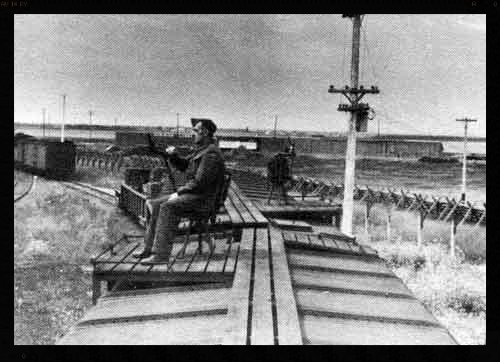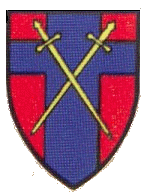BAOR
27CIB
Hardration et al,
Reference: Rail Way Guns by Hardration, 27/3/2013 concluding with the challenge,'' I'm sure there will be some interest and stories to follow''.
Yes, There is a relevant and long hidden national story which involves a unit from my former Regiment, the 99th Fd Bty of the 21 FD Regt RCA(M) located in Wingham, Walkerton & Listowel, ON. Unfortunately there are few members of the BAOR forum who are old enough to recall the place and time of the events described below. One exception is forum member TonyE. This story is about Canada's only Armoured Train which involves gunners from 99Bty. The setting is the Skeena River, the second largest river in the province of British Columbia and it takes place on a navigable section of the river starting at Terrace, BC and running south west to Prince Rupert BC on the Pacific coast (54degrees 09' 0''). A poorly maintained Canadian National Railway line followed the banks of the Skeena along the same stretch of the river for 90 miles.
The time period of the story commences in Feb 1942 when the American Army Engineers start to build the Alaska Highway working south from Delta Junction in Alaska and at the same time working north from Dawson Creek BC, an incredible distance of 2,700km (1700miles). Overcoming enormous difficulties such as sub zero temperatures, raging blizzards, tundra, permafrost, and bridge building, the highway or trail is unbelievably completed in Oct 1942. As a response to this initiative , the Japanese on 3 Jun 1942 bomb Dutch Harbor and land assault forces on the islands of Attu and Kiska in the Aleutian island chain running SW from Alaska into the Pacific Ocean. The Japanese strategy is to try to protect the Northern flank of their growing empire in the Pacific. In 1943 a force of ca 34,000 American troops and a Canadian force of ca 5,000 conscripts from Canada's 6th Div. is assembled to drive out the invaders, only to find ,surprisingly, that the Japanese withdrew their forces from the islands on 28 Jul 1942. A surprising aside to the use of Canadian conscripts was a promise made by the Canadian Government when Conscription was inaugurated that conscripts would not have to serve "overseas". But since the theatre of operations for this attack was in homeland BC, the Govt. deemed themselves to have kept their promise.
Now getting back to the setting for the story on the Skeena River, the strategists at Canadian defense HQ anticipated that the Japanese might try to use the Skeena River followed by an overland route to interdict the Alaska Highway. A plan was formulated to construct an armoured train to deny the enemy the use of the river. The Canadian National Railway was ordered to provide a ten wheeler steam locomotive -4-6-0 and tender along with the rolling stock all of which were to be converted at the Transcona Rail Yards in Winnipeg, Manitoba. The military were ordered to provide the following military equipment:
2 - 75mm howitzers to be provided by the US Navy
4 Bofors anti aircraft guns
2 search lights powered by a diesel generator.
Anti aircraft machine guns with moorings and mortars
Welders at the Transcona Yard were ordered to weld armour plating varying from 10-16mm to the locomotive following plans submitted by Defense HQ. The story was told that the lead welder advised the military brass on site that the poorly maintained road bed and the light rail track would not support the extra weight. He was ignored. Meanwhile the military units to staff the train were mustered and transported to Terrace, BC It consisted of the following
Locomotive engineer, 2 firemen, conductor, 2 brakemen, all civilian employees of the CNR
One coy of the Winnipeg Grenadiers
99th Fd Bty RCA to provide the gun crews
Along with various other support personnel
The armored train consisting of 8 or 10 cars with the locomotive in the centre arrived at Terrace on 2 Jul 1942 and did a test run on 29 Jul. As the welder had predicted the excessive weight of the locomotive and reinforced rolling stock along with the guns tore up the rails from the ties on the roadbed causing derailments. The train was immediately returned to Vancouver for modification and when it returned the locomotive had been shed of its armour. Strict speed limits were employed like 15mph and lower on curves. It took about 12 hours to make the one way trip from Terrace to Prince Rupert.
The following pictures give the readers a glimpse of Canada's only and very short lived armoured train which ceased operation in Oct 1943 without ever firing a hostile round.


"And you tail gunners thought you had it tough" a quote from Roger V. Lucy's book


There was a similar four or five car unit as shown at each end of the locomotive which was in the centre. There was also a car for each of the 75mm guns at the front and rear end of the train. Sadly there are no pictures to be found of the armoured locomotive.
Picture sources are from the Transcona Historical Museum collection in Winnipeg.
Further sources:
The No.1 Armoured Train; WW11 Along the Skeena by Jane Stevenson from the
magazine " Northword", Oct 2009 edition.
The Armoured Train in Canadian Service by Roger V. Lucy
Canada's Best Kept Secret of WW11, The Armoured Train by Ted Hacket
Enjoy

